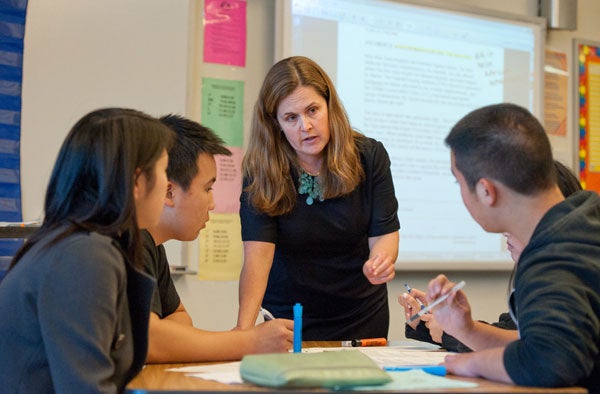|
View video here.
March 5, 2012
Stanford researchers bring life to high school history classes with a curriculum built around historical documents
Students who used the "Reading Like a Historian" curriculum outperformed their peers in traditional history classrooms, study finds. By Brooke Donald

Valerie Ziegler, center, a teacher at Lincoln High School in San Francisco, leads students through an exercise that evaluates possible biases in a photograph taken during the Depression. (Photo: Linda A. Cicero / Stanford News Service) There are no orderly rows of desks in Valerie Ziegler's high school history class – students sit in groups of three or four at small tables around the room. There also is no lectern because there are no lectures. And perhaps most striking, there are no textbooks.
The 11th-grade class at Abraham Lincoln High School in San Francisco learns about the Vietnam War, women's suffrage, civil rights, the Great Depression and other major events in U.S. history by analyzing journal writings, memoirs, speeches, songs, photographs, illustrations and other documents of the era.
"I always tell my students they're historians-in-training, so the work we do in here is that of a historian," Ziegler said.
The nontraditional curriculum Ziegler uses, called Reading Like a Historian, was designed at Stanford and is among the projects of the Stanford History Education Group.
The curriculum was introduced in 2008 at five schools in the San Francisco Unified School District as part of a study by Abby Reisman, who was the head curriculum designer while completing her doctoral work at Stanford.
It is now available through a partnership with the district to any teacher who chooses to use it and is free to download from the Internet. The program is also being developed for middle-school students.
"In all too many history classrooms, it's still the single voice of the textbook that students hear," said education Professor Sam Wineburg, who directs the Stanford History Education Group. "We need to break the stranglehold of the textbook by introducing students to the variety of voices they encounter in the past through primary sources."
The goal is to improve literacy skills, foster a love of learning and of history, and increase critical thinking and reading comprehension.
And it seems to work.
Reisman's evaluation of the curriculum is published in the current issue of the journal Cognition and Instruction.
At the end of the initial yearlong intervention, students in Reading Like a Historian classes were assessed on their reading comprehension, historical thinking, recall of historical facts and general reasoning.
"What we found is that the students in Reading Like a Historian classrooms outperformed their counterparts in traditional classrooms on all four measures," said Reisman, who directed the study and is now a senior researcher at the National Center for Research on Evaluation Standards and Student Testing at UCLA.
Reisman said it wasn't surprising that the students did so well with reading comprehension since the curriculum is built around manuscripts and other documents that are read during every lesson.
The most unexpected result, she said, was how well the students did in recalling historical facts – dates of wars, who was president, how did an event happen.
"You would imagine that students in traditional classrooms who are doing the textbook curriculum, who are getting lectures, who are asked to memorize would have done better," said Reisman.
"But it turns out that embedding historical content in meaningful activity leads to better recall," she added.
Each lesson in a Reading Like a Historian class begins with a question: Was the New Deal a success? Was President Abraham Lincoln racist? How could it be that there were women who wanted to deny women the right to vote?
Students are then given documents to examine carefully, something Reisman and Wineburg say is rare in today's history classrooms. Students ask questions and argue about interpretations.
"It's very, very different from conventional instruction, where the student is prepared to repeat what the textbook says rather than to articulate and defend a belief that they have based on evidence," Wineburg said.
The curriculum was designed to meet California standards for history education but also can be used as a companion to a textbook-driven class in places where lessons are mandated by districts.
"The last [history] class I had taken was more notes, more lectures," said Stephanie Luo, an 11th-grader in Ziegler's class. "This one is more hands-on discussion. You get to actually dig your hands into history."
Students describe delving into manuscripts, annotating texts and examining presidential speeches. They seek to find out why a document was written, and the motivations of the writer.
In a recent class, they evaluated a "fireside chat" given by Franklin Roosevelt and analyzed Dorothea Lange's 1936 photograph Migrant Mother.
"In English class, we just read a book and that's the end of it," says Brittany Jackson, a 12th-grader who took Ziegler's class last year. "In this class, we read the book, we read actual documents, we go places and see things for ourselves."
Jackson said the structure of the class improved her speaking and reading skills, which helped in coursework outside history.
Ziegler, who has taught history for seven years, said the Reading Like a Historian program has made her class more rigorous.
"This curriculum has really allowed me to push my students further than before," she said. "Push them to read and push them to analyze and push them to critically think."
She also said it's more fun to teach.
"As a teacher you're always looking for new ways to enhance your classrooms," Ziegler said.
Apparently Ziegler is not alone. So far, teachers nationwide have downloaded the curriculum more than a quarter of a million times.
-30-
|